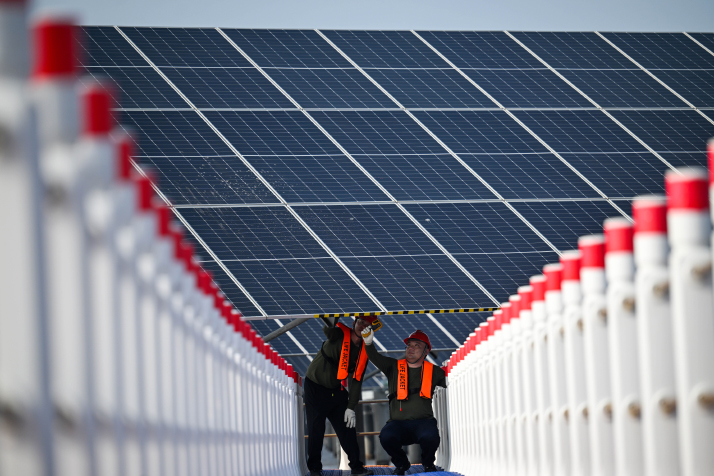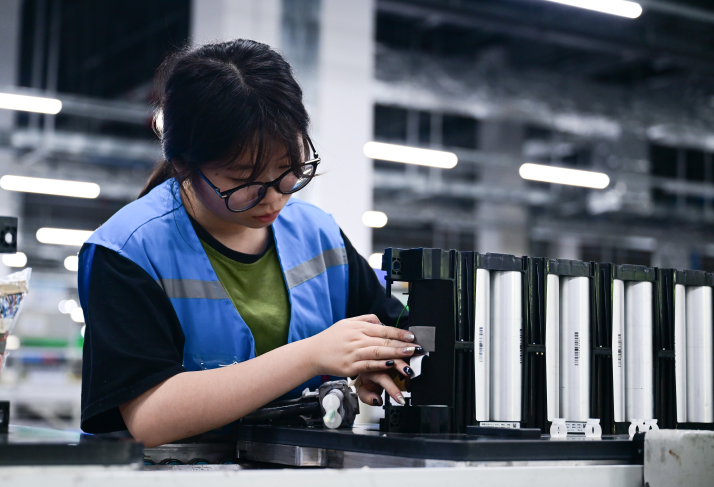| Business |
| China is confronting its industrial rat race | |
| Rat race competition refers to a destructive cycle in which market entities pour increasing amounts of effort and resources into competing for a limited market without generating real gains in overall productivity or returns | |
|
|
 Technicians inspect photovoltaic panels at a solar power station in Tianjin on July 10 (XINHUA)
In recent years, electric vehicles, lithium-ion batteries and solar cells have become known as China's "new trio," as they represent the country's emerging export staples replacing the "old trio" of garments, furniture and home appliances. The rapid entry of this new products to the global market is providing momentum for the worldwide green transition, and their success has made them magnets for capital, with companies and local governments across the country racing to join the action. But this gold rush has come at a cost. As production capacity ballooned, profit margins thinned and, in many cases, vanished altogether. Fierce price wars erupted, and players in the sectors found themselves locked in a cutthroat rat race. Rat race competition refers to a destructive cycle in which market entities pour increasing amounts of effort and resources into competing for a limited market without generating real gains in overall productivity or returns. At the corporate level, this kind of competition often shows up as brutal price cuts. Others jump into fast-growing sectors without thinking about whether they have the skills or resources to succeed. This leads to too many companies making the same kind of products. On top of that, many focus more on flashy ads than on real quality, using hype to chase short-term gains instead of building lasting value. Some local governments also add to the problem. To attract businesses, they offer irrational tax breaks, disrupting fair market dynamics. Others blindly copy what's successful in other regions, launching big projects without considering their own local conditions, resulting in redundant infrastructure and wasted resources. In some places, protectionism sets in, with authorities giving preferential treatment to hometown firms, further eroding the foundations of a level playing field. Since last year, the central authorities have taken decisive steps to rein in rat-race competition. The message has been consistent: The cycle of excessive, unproductive competition must be broken. A July 1 meeting of the Central Commission for Financial and Economic Affairs, China's top financial and economic policymaking body, emphasized accelerating the development of a unified national market. It also called for regulating disorderly price competition and guiding businesses to improve product quality and phasing out outdated production capacity in a systematic way.  A technician works on a new-energy vehicle battery production line in Hefei, Anhui Province, on June 30 (XINHUA)
When growth turns costly A key driver behind this wave of rat-race competition is a structural mismatch between supply and demand, Wang Xiaosong, a research fellow at the National Academy of Development and Strategy of Renmin University of China, told Beijing Review, adding that the imbalance has sharpened competition and, in many cases, pushed industries deeper into price wars. China's new-energy vehicle (NEV) industry has seen explosive growth, with production and sales leading the world for 10 consecutive years, playing a key role in the global push toward carbon neutrality. NEVs refer to vehicles completely or mainly driven by new energy sources, including battery electric vehicles, plug-in hybrid vehicles, and fuel-cell vehicles. But behind the headline numbers lie growing concerns. According to the China Automobile Dealers Association, profit margins in the auto industry fell to just 4.3 percent in 2024, below both the average of downstream industries and the previous year's level. Among domestic NEV brands, only a handful, including BYD, Seres and Li Auto, are currently profitable. Meanwhile, research and development (R&D) spending has declined across several manufacturers. "While slashing prices may boost short-term sales and attract cost-sensitive customers, it also squeezes already thin profit margins," Tian Xuan, President of the National Institute of Financial Research of Tsinghua University, told state broadcaster China Central Television. "This leaves less room for investment in R&D, quality control and after-sales service, ultimately weakening the industry's long-term competitiveness." "The rat race also distorts the entire industrial ecosystem," Tian said. In the rush to lower prices and cut costs, some firms have resorted to using their market dominance to pressure suppliers, delaying payments and shifting financial risk across the supply chain. Data show that in 2024, profit margins in China's auto parts and accessories sector dropped by 0.3 percentage points year on year, while overall debt levels rose by 10.6 percent. Tian said high-quality development is marked by strong innovation, the ability to anticipate demand, brand influence and robust core competitiveness—all reflected in superior products and services. At its core, it means a healthy economic cycle where investments yield returns, businesses generate profits, employees earn stable incomes and governments collect sustainable tax revenues. The rat-race competition, by contrast, channels excessive resources and inputs into low-efficiency rivalries. It stifles innovation, disrupts the formation of a dynamic supply-demand balance, and drags down wages, tax revenues and investor confidence, ultimately weighing down the economy's long-term growth potential, he said. From price to value "The key difference between virtuous competition and a rat race lies in how each affects market price signals," Wei Qijia, Director of the Industrial Economy Research Office at the State Information Center's Department of Economic Forecasting, told a forum in July. Under virtuous competition, supply and demand reach a dynamic balance, and the resulting price signals act like traffic lights—coordinating production and consumption in a smooth, efficient manner that benefits producers, consumers and society at large. The rat-race competition, by contrast, ignores costs, distorts prices and breaks the link between real supply and real demand. To gain market share, some firms undercut prices to levels far below production costs, disrupting the market and corrupting price signals across the industry. This weakens sector-wide competitiveness and ultimately harms consumer interests. To break this cycle, Wei proposes a holistic approach combining using standards and regulations to curb irrational competition, intensifying legal actions against irrational price wars and unfair pricing practices with suppliers, and rolling out targeted policies to stimulate effective demand and boost household consumption. Major reforms focused on building a unified national market and strengthening the foundations of China's market economy are already in motion. Earlier this year, the National Development and Reform Commission, the country's top economic planner, released the guideline for building a unified national market, explicitly warning against the adoption of policies that hinder fair competition. Measures to enhance the implementation of the fair competition review regulations took effect on April 20. The measures target cutthroat competition in regional investment promotion, requiring that all incentive policies ensure legal compliance, fairness and equal treatment. Key industries are actively getting out of the rat race. About 20 carmakers, including BYD, FAW, GAC, NIO and Xiaomi, agreed to limit predatory pricing tactics and adjust payment terms, committing to a 60-day settlement period for suppliers, effective from July 10. Leading photovoltaic glass manufacturers have announced a 30-percent output cut starting in July. The China Cement Association issued a directive on July 1, calling for supply-side reforms and structural upgrades. In the steel sector, several producers have already received notices to scale back production and emissions. Stock analysts argue that conquering rat-race competition requires action on both the supply and demand sides. As sector-specific policies continue to roll out, they expect profitability across affected industries to improve—potentially setting the stage for a new round of market rally. BR (Print Edition: Putting the Brakes on Overdrive) Copyedited by G.P. Wilson Comments to zhangshsh@cicgamericas.com |
|
||||||||||||||||||||||||||||
|